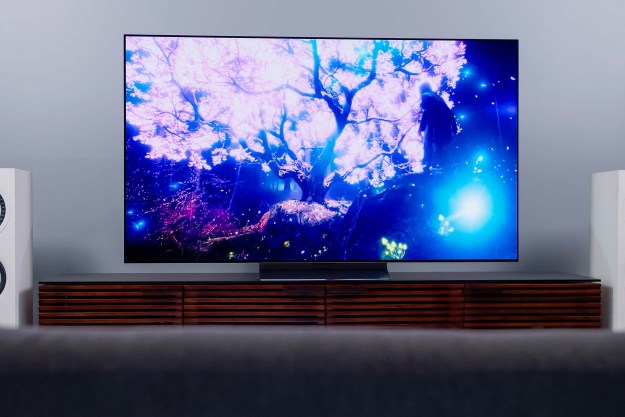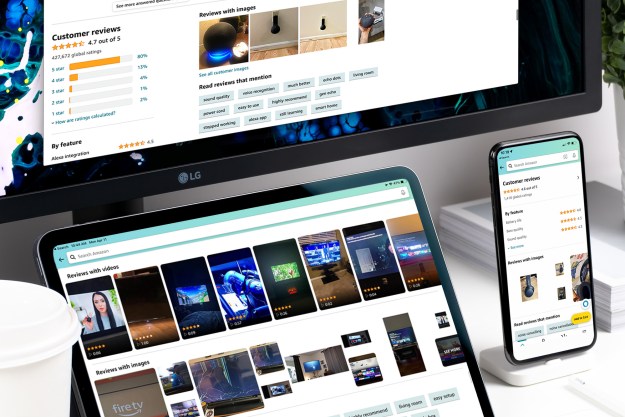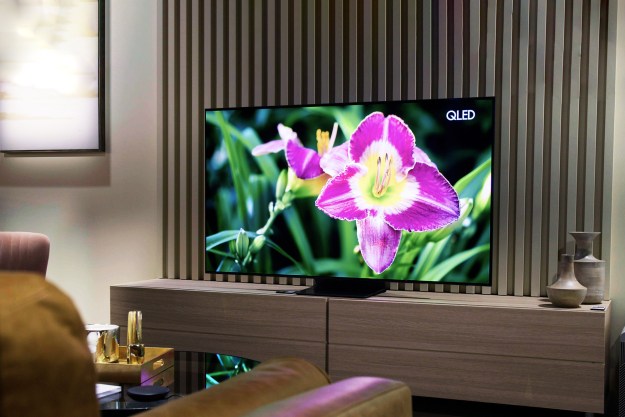Philips 42PF9831D
MSRP $3,999.99
“We believe that Philips is truly starting to up the ante, and the Philips 42PF9831D is probably one of their best TV”
Pros
-
Good picture quality; lots of features; stylish remote; full ambilight
Cons
-
Quirky auto-picture settings; no 1080p support
-
only one coaxial input
Summary
Philips has had an uphill battle convincing the “experts” that Ambilight is truly a feature worth paying attention to, yet they keep fighting. This time around however, Philips has taken their gloves off, offering an
LCD TV with just about every conceivable feature; a compelling offer whether you like Ambilight or not. The new Philips 42PF9831D 42-inch LCD TV uses the company’s new Ambilight 4 technology to help create a truly moving experience to the viewer – that is, if you let it. The Philips 42PF9831D has a retail price of $3999 which proves that LCD prices equal to and above 42-inches have really plummeted to affordable levels. While the 42PF9831D may seem to have an unlimited amount of features for this price range, it could all be in vain if the picture quality does not live up to the buyer’s expectations. Read our full review for the low-down.
Features and Design
For being a 42-inch display, the Philips 42PF9831D is a lot larger in size than what you might expect. That’s because the built-in canvas that surrounds the actual LCD panel adds several inches to the TV’s size on all sides. Using Ambilight 4 technology, there are 4 separate color lamps that project lighted color to whichever side it needs to and directly onto the built-in canvas. On previous generation Ambilight models, light was only projected to two sides rather than four, and with the built-in canvas on all sides, you are guaranteed even dispersion without using your own wall for the background. It’s a good idea, but you’d better make sure that you have room in your home theater setup for a setup of this size.
In addition to the Ambilight 4 feature, the Philips 42PF9831D has a lot of new or enhanced features to tout. For starters, it incorporates Pixel Plus 3 HD technology which is supposed to help enhance the vibrant and sharper images put out by HD signals. How do you enhance an HD picture? Well it’s all subjective of course, but the premise here is that the Pixel Plus 3 HD technology will take the pixel of the image being shown and “blend” it in a way to match the surrounding pixels. The result is supposed to be a slightly softer and more natural picture.
The second major technology at work here is Philips Clear LCD feature. Ever notice while watching a sports event or a scrolling stock ticker on an LCD, that it just didn’t look right? We have noticed ghosting and trailing on the older LCD TV’s typically due to a slow screen refresh rate, among other factors. Philips Clear LCD is supposed to eliminate flicker and work with the backlight module to produce a high contrast ratio and better viewing angles (up to 170 degrees).
The Philips 42PF9831D also has a 16:9 aspect ratio and a 1366 x 768p resolution, including a 4500:1 contrast ratio. Sorry folks, no 1080p here.
As for connectivity, the Philips 42PF9831D pretty much supports it all. On the right side of the TV there is an 7 -in-1 memory card slot which is compatible with Compact Flash I and II, Sony Memory Stick, SD card or Mini SD Card, Smart Media, Micro Drive, and Multi Media Card. The 42PF9831D also comes with 2 component video input, 2 HDMI inputs, S/PDIF coaxial digital in, Cable card support and two USB ports.
We love the design and look of the Philips 42PF9831D TV. While the set is larger than a typical 42-inch LCD due to its built-in canvas, the frosted glass stand and black bezel on top of the white canvas give it a very modern edge. In addition, the remote compliments the set with an equally sleek, hip look. Philips definitely took a gamble here with its design, and we think they put their money in the right place.
 Image Courtesy of Philips
Image Courtesy of PhilipsSetup and Use
Upon powering up the Philips 42PF9831D TV you are greeted by an onscreen wizard, which reminds us of something you would see from a PC system. It will walk you through each step of the setup process and ask what type of signal you are using, whether it’s Cable, OTA (Over-the-air), HD, or SD etc. Once you let it know where you will be getting your content from, the set will automatically scan and program the channels. Now, something you will need to watch out for is that the Philips 42PF9831D only comes with 1 coaxial input. So if you plan on connecting regular analog cable (please tell us you are not), AND an antenna for catching HD signals, you are out of luck. Another thing to worry about is that while Comcast Digital Cable boxes typically provide output using either RCA or S-Video connections, most people still wind up using the coaxial connection. Do not do this, and save the coaxial jack for an HD antenna (unless you plan to get HD content through your satellite or cable company)!
The built-in ATSC and NTSC tuners did a great job scanning our area for HD and SD signals. We were able to pick up at least 7 channels broadcasting locally, using a $30 Sharp HD/UHF antenna, in a building with concrete walls – we were stunned! However, we disliked the fact that this set would mix both the HD and SD channels. One of the benefits to having multiple coaxial inputs is that you can switch between the inputs from analog cable to OTA HD if you chose to. Otherwise, you can just mark the channels you want as favorites and access them that way – we know, we are too picky!
For the most part the Philips 42PF9831D really does deliver on its promises. The picture quality looks great from typical viewing distances (7-15 feet) and we only noticed picture fading and color loss at the most extreme viewing angles. Philips says that you should be able to watch HD quality content at up to 170 degree without picture loss, and they sure got close (but we did notice some degradation). For an LCD though, we are very impressed with the Philips 42PF9831D capabilities.
The Right Side of the 42PF9831D
The Left Side of the 42PF9831D
LCD TV’s have always been hit and miss in regard to picture quality. You have black levels, ghosting, brightness, contrast, and color issues to deal with on most TV’s, but they always seem to be on the extreme end when it comes to fine tuning the picture on an LCD. The Philips 42PF9831D certainly seems to make this easier. Philips Clear LCD definitely helps with creating bright, colorful, and vibrant images. Although, depending on what you are watching, it might feel a little over exaggerated. The preset movie modes work, but even then we found ourselves calibrating each of the modes to our liking; thankfully the built-in memory remembers your settings. As with most LCD TV’s make sure that you give yourself plenty of viewing distance when viewing the screen. If you are too close, you will notice a grainier picture. We found that from about 7 feet on, the picture looked the best. LCD’s have always had an arguably more vibrant picture than their plasma counterparts, and that works for and against them. Some content looks terrible when it’s sharpened too much or if it’s poorly recorded, and unfortunately an LCD will expose that flaw.
One incredibly nagging issue we encountered was the auto picture size setting. This setting is supposed to resize the screen depending on what you are watching. A DVD movie shot in 16:9 for example would resize to the appropriate size automatically. But when you are watching HD content broadcast over the air, a commercial might be shot in 4:3 while another is in 16:9. In this case, the auto setting went back and forth. It was cool at first and then became a huge annoyance. It would be great if the TV said “Ok this is an HD channel,” and just kept everything in 16:9 mode, forcing you to manually change the setting here if you need to.
The media card slots and USB inputs are great for showing your media directly through the set without using a PC. For media types, this LCD supports MP3’s, JPEG, and .alb slideshow files. You can also connect a digital camera directly to the Philips 42PF9831D using the USB ports.
The included remote control has a very modern look to it that we like. However, the piano black finish is a little too extreme and will smudge easily. The buttons are backlit and respond from a decent range.
 Philips 42PF9831D Remote Control
Philips 42PF9831D Remote Control
Of course we saved the best feature for last, the Ambilight 4 technology. Like we mentioned in the introduction, this has been very hit or miss with the professional world. A lot of reviewers think the whole “Ambilight thing” is nothing more than a gimmick. Does it really reduce eye-strain and make the viewing experience that much better? Well, it didn’t do much to relieve our poor eyes but it undoubtedly looks very, very cool. Everyone who came in to view this LCD loved the full-surround ambilight feature and believed it to add to the overall viewing experience. With Ambilight 4, you not only have light coming from all four sides, but one side could be a completely different color than the other depending on the content being played. If you find that Ambilight is bothering you, simply turn it off, but if you don’t want the Ambilight at all, we suggest buying a different set altogether.
The Ambilight Changes Color Depending on the Image
Conclusion
We believe that Philips is truly starting to up the ante, and the Philips 42PF9831D is probably one of their best TV’s yet. We found most of the advertised features worth-while and we are pleased with the TV’s performance. The remote control looks cool, but smudges too much. We would have also preferred another coaxial input for those still in the HD transition stages. With an MSRP of $3999 and an estimated street price around $3600 the Philips 42PF9831D is in a competitive space. If Ambilight is really a feature that interests you, then rest assured that the Philips 42PF9831D will feed that desire – it’s a fun TV to own.
Pros:
-Good picture quality
-Lots of features
-With exception to lack of 1080p support, it has good longevity
-Full-surround Ambilight looks great and works well
-Stylish remote control
Cons:
-The “Auto” picture setting works too well, annoying with an HD signal
-Remote control easily smudges
-No 1080p support
-Only one coaxial/tuner input
Editors' Recommendations








